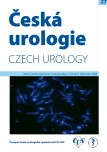Priapism durning testosterone replacement therapy of the central hypogonadism
Authors:
Marek Broul 1,2; Jana Laštůvková 3; Vlasta Čejnová 3; Lucie Lišková 3; Filip Cihlář 4
Authors‘ workplace:
Sexuologické oddělení, Krajská zdravotní, a. s., Masarykova nemocnice v Ústí nad Labem, o. z.
1; Urologické oddělení, Krajská zdravotní, a. s., Nemocnice Litoměřice, o. z.
2; Oddělení lékařské genetiky, Krajská zdravotní, a. s., Masarykova nemocnice v Ústí nad Labem, o. z.
3; Radiologická klinika Fakulty zdravotnických studií Univerzity J. E. Purkyně v Ústí nad Labem, a Krajské zdravotní, a. s. – Masarykovy nemocnice v Ústí nad Labem, o. z.
4
Published in:
Ces Urol 2023; 27(2): 116-121
Category:
Case report
Overview
We present a case report of a patient who suffered from recurrent priapism after testosterone replacement therapy (TRT) for central hypogonadism. This complication of TRT is very rare and poorly described in the literature. The patient had to undergo cavernous body lavage but still experienced recurrent priapism. It was only after anti-androgen therapy was administered that the recurrence of priapism ceased.
Keywords:
testosterone – hypogonadism – Testosterone replacement therapy – priapism – anti-androgen treatment – 16p11.2 microdeletion syndrome.
Sources
1. Reif F. Priapismus. Urol. praxi. 2005; 2(3): 122–125.
2. The EAU Sexual and Reproductive Health Guidelines. Uroweb – European Association of Urology. 2023. https://uroweb.org/guidelines/sexual‑and‑reproductive‑health.
3. Študent V, Hrabec M, Vidlář A, Hartmann I. Priapismus. Urol. praxi. 2001; 3: 122–125.
4. Křenková P, Piskáčková T, Holubová A, et al. Distribution of CFTR mutations in the Czech population: Positive impact of integrated clinical and laboratory expertise, detection of novel/de novo alleles and relevance for related/derived populations. Journal of Cystic Fibrosis(online). 2013; 12(5): 532–537. ISSN 1569-1993. doi:10.1016/j.jcf.2012. 12. 002.
5. Krausz C, Hoefsloot L, Simoni M, Tüttelmann F. EAA/EMQN best practice guidelines for molecular diagnosis of Y‑chromosomal microdeletions: state‑of‑the‑art 2013. Andrology. 2014; 2(1):5–19. ISSN 2047-2927. doi:10.1111/j.2047-2927.2013.00173.x.
6. Bachmann‑Gagescu R, Mefford HC, Cowan CH, et al. Recurrent 200-kb deletions of 16p11.2 that include the SH2B1 gene are associated with developmental delay and obesity. Genetics in Medicine. 2010; 12(10): 641–647. ISSN 1530-0366. doi:10.1097/GIM.0b013e3181ef4286.
7. Ruch W, Jenny P. Priapism following testosterone administration for delayed male puberty. The American Journal of Medicine. 1989; 86(2): 256. ISSN 0002-9343. doi:10.1016/0002-9343(89)90286-6.
8. Zelissen PM, Stricker BH. Severe priapism as a complication of testosterone substitution therapy. The American Journal of Medicine. 1988; 85(2): 273–274. ISSN 0002-9343.
9. Zargooshi J. Priapism as a complication of high dose testosterone therapy in a man with hypogonadism. The Journal of urology. 2000; 163(3): 907. ISSN 1527-3792. doi:10.1016/s0022-5347(05)67836-6.
10. Burnett AL, Kan‑Dobrosky N, Miller MG. Testosterone Replacement with 1% Testosterone Gel and Priapism: No Definite Risk Relationship. The Journal of Sexual Medicine. 2013; 10(4): 1151–1161. ISSN 17436095. doi:10.1111/jsm.12059.
11. Fernández‑Balsells MM, Murad MH, Lane M, et al. Adverse Effects of Testosterone Therapy in Adult Men: A Systematic Review and Meta‑Analysis. The Journal of Clinical Endocrinology & Metabolism (online). 2010; 95(6): 2560–2575. ISSN 0021-972X, 1945-7197. doi:10.1210/jc.2009-2575.
12. Shegrill IS, Pranesh N, Hamid R, et al. Testosterone induced priapism in Kallmann’s syndrome. 2003; 169(3): 1089. ISSN 0022-5347.
13. Ichioka K, Utsunomiya N, Kohel N, et al. Testosterone‑induced priapism in Klinefelter syndrome. Urology. 2006; 67(3): 622.e17-622.e18. ISSN 0090-4295.doi:10.1016/j.urology.2005. 09. 041.
Labels
Paediatric urologist Nephrology UrologyArticle was published in
Czech Urology

2023 Issue 2
Most read in this issue
- Prognostic factors in metastatic prostate cancer
- 5th edition of the 2022 WHO classification of prostate cancer: changes and novelties in the "Blue Book"
- Early complications after radical cystectomy before implementation of the ERAS concept (Enhanced Recovery After Surgery)
- The results of percutaneous nephrostomy tube placement under ultrasound guidance
